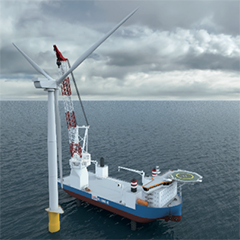Since the beginning of this year, US states together have committed to approximately 8,200 MW of offshore wind by 2030. This is a substantial amount of work and provides a visible pipeline of work justifying investments in dedicated and efficient installation solutions. Are these the right conditions to invest in a new build installation jack-up? PES explores the opportunities and hurdles with GustoMSC, a design and engineering company of mobile offshore units and equipment.
There is an increasing interest from companies looking to participate in the US offshore wind installation market. Various parties are investigating and preparing in order to be able to invest in the construction of a wind turbine installation jack-up in the future. Parties are considering designs, potential shipyards and discussing with developers and turbine manufacturers.
There have been several announcements but to date no company appears to have made a solid commitment to build yet. What are the bottlenecks why are commitments not forthcoming?
Last year, the States of Massachusetts, New York and Rhode Island published a report ‘U.S. Jones Act Compliant Offshore Wind Turbine Installation Vessel Study’. GustoMSC has been working on this report for the New York State Energy Research and Development Agency (NYSERDA). The report is aimed at understanding what is required for a wind turbine installation vessel on the US East Coast from both the technical and financial perspectives.
Technical aspects
Currently there is no equipment available in the US that is capable of installing present and future heavy foundations and turbines, due to insufficient carrying and lifting capability, in terms of both capacity and height.
In very nice weather we have seen tower and blade components, for 6 MW turbines, being feedered by US liftboats. With planned turbine sizes of 8+ MW for the upcoming US projects this will be increasingly difficult as the size and weight of components are larger and heavier.
Furthermore, for projects with an increasing number of turbines, robustness margin in terms of allowable installation conditions, becomes more and more important. For an efficient installation campaign, the weather windows cannot be too tight. Liftboats were not designed for sailing with cargo, in heavy sea conditions and have very limited payload capacity.
But when it is decided to build new vessels, construction of a suitable jack-up will take roughly 2.5 to 3 years from signing to delivery, depending on the type of jack-up. The earliest developments have planned delivery dates from 2020 onwards and increasing in volume from around 2022-2024 and onwards. This means that a new-build jack-up may not be available for the first wave of US projects but may be become available at a later time when activity is expected to pick-up.
Developers cannot wait for a dedicated jack-up to become available and so will be forced to go for alternative installation solutions by means of a non-Jones Act compliant jack-up, as there is no suitable equipment in the US market available.
Currently sufficient European units appear to be available and able to install US wind turbines. Whether this will still be the case in the future will depend on global market conditions and requirements, with respect to foundation weights and turbine sizes. Larger turbines, or a raised activity level on the European wind market, heavily affects the availability of suitable European installation jack-ups for the US East Coast projects.





















